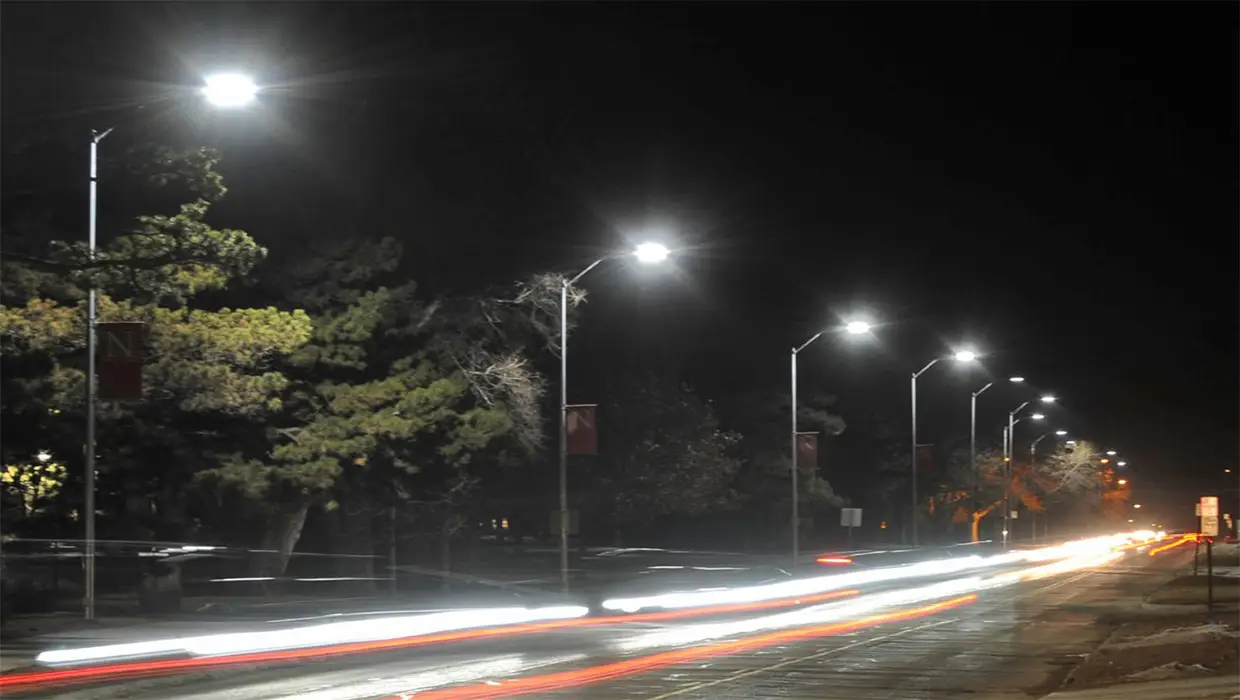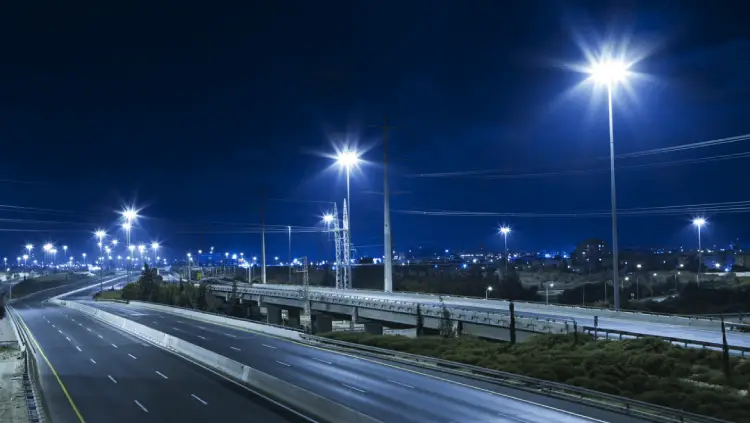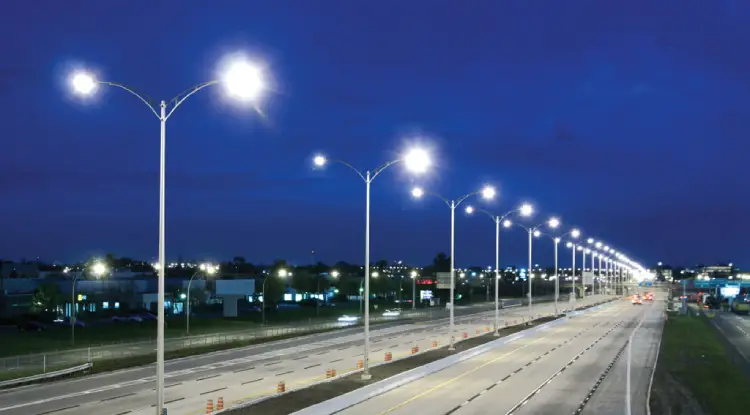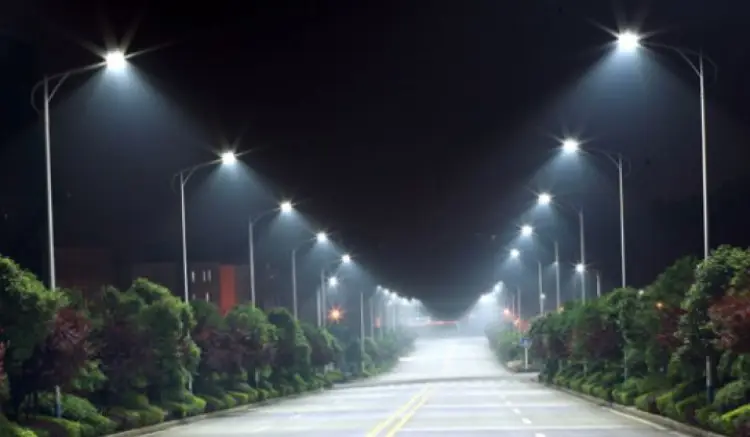Introduction
For a long time, traditional light sources, high-pressure sodium lamps, and some metal halide lamps have been playing a leading role in road lighting. In recent years, domestic LED lighting applications have developed rapidly. Many manufacturers have introduced high-power LED street lights, which are increasingly used in road lighting as energy-saving products. This article discusses the development and several problems of LED street lights.
The government’s street light bidding has given a great platform for the development of LED lights. Especially in recent years, climate change has been frequent and reduction of carbon emissions has been the consensus of various countries. LED street lights have a huge advantage in energy-saving, which makes LEDs have a great advantage in the bidding process. Many countries and regions have begun to use LED street lights to replace other street lights.
Advantages of LED
As a semiconductor luminescent material, LED has attracted attention at home and abroad for its advantages of high efficiency, reliability, and durability. With the continuous development and progress of semiconductor technology, LED applications can be said to be ubiquitous. Besides, the acquisition of white light, the improvement of efficiency, life, stability, and the continuous reduction of costs have expanded its applications. In recent years, LED has achieved certain success in the field of landscape lighting. The development of LED street lights has opened up a broader world.
Compared with traditional light sources, LEDs have outstanding advantages in color rendering, energy saving, environmental protection, life span, and digital controllability. And myths about LED lights are easy to break. We believe that after gradually solving the key technical problems of LED street lights, and realizing a substantial reduction in cost, LED light sources also have a good development prospect. At present, hundreds of companies have invested in the development of LED street lights. Some of their products have been put into mass production.
Tests of LED
In recent years, LED lighting applications have developed rapidly. Many manufacturers have introduced high-power LED street lights, which are increasingly used in road lighting as energy-saving products. In order to protect the environment and reduce carbon emissions, many government purchases evaluate and test the lighting of various manufacturers. Survival of the fittest is the law of nature. If product technology and quality are not improved, they will naturally lose the competition. Launching high-power products is only the first step. How to launch high-quality high-power LED street lights is the key.
Different countries have different standards, but most of them will perform the following performance tests. Carry out 12 times of road average illuminance Eav and uniformity UE test and other data tests on the LED. At the same time, it also needs to carry out lamp input power test, lamp power factor test, light efficiency test, lamp light distribution curve test, color temperature, color coordinate, chromaticity capacity tests of color characteristics such as difference, color rendering index, low-voltage line harmonic content, grounding measures and dielectric strength and IP rating of lamps. Also, make an evaluation of light decay and visual effects.
Problems of LED street lights
Under the prominent situation of global energy crisis, the application of LED light source has become a hot spot in recent years. When applying LED street lamps, what are the special requirements for technology, what are the advantages of LED street lamps, what are the shortcomings, and how to solve a series of problems of LED street lights are worthy of our serious study.
Standardization and versatility
The problem
The LED street lights currently launched have a variety of product appearances, the arrangement, and quantity of LED luminous particles, the external size and internal design of the rectifier circuit. For example:
- The power of a single tube is different, ranging from 1 to 5 watts.
- The light distribution is different, and there are bat-shaped, rectangular, butterfly wing, etc.
- Their optical processing method use their own lens to avoid secondary optical processing.
- The package situation includes multi-chip packaging and single-chip packaging;
- Technical circuit conditions include mold, group high-power, chip-integrated high-power, dot-matrix high-power, etc.
- The power supply assembly also has its own integrated and external power supply.
- The heat dissipation technology has its own merits, which brings great inconvenience to the operation and maintenance work after popularization. Some do not conform to the standardization and universal design principles of municipal public facilities.
Solutions
In the future development process, manufacturers should follow the national unified standards to ensure equipment safety and electrical performance. At the same time, manufacturers must provide the following guarantees for product standardization and uniformity.
For products of the same enterprise at different stages of development, the standard and uniformity of main electrical components must be ensured. For products of different enterprises, the main electrical components such as rectifier circuits should be based on national standards.
The photoelectric and thermal characteristics of LEDs are very different from those of traditional light sources. So it is hard to measure LEDs using the methods for traditional lighting sources. LEDs lack appropriate standards in product specifications or measurement, resulting in a wide variety of products and irregular markets. The diversity of products also makes it impossible for companies to concentrate on large-scale production. The formulation of relevant LED standards has become an urgent need for the industry. At present, the “National Standards and Industry Standards for LEDs for General Lighting” proposed by the National Technical Committee for Standardization of Lighting Appliances are in the review stage and are expected to be promulgated and implemented one after another. Relevant enterprises should carry out new market positioning and product planning and invest in necessary quality assurance measures.
Optical design and heat dissipation
The problem
Although the development of high-power LED street lights is fast, there are still different degrees of low-watt lumens, low secondary light effect treatment level, low system light efficiency, fast light decay, short life, and color temperature deviation. A series of problems of LED street lights such as different light and color, multiple failures of the drive. Among them, the main technical issues such as secondary optical design, heat dissipation design, and power supply regulator system design are the key to improving luminous efficiency and prolonging life.
Solutions
Design of the secondary optical system
The design of the secondary optical system of the LED is very important to the light distribution and optical output efficiency of the LED street lamp. Good road lighting requires that the light distribution of LED street lamps is a rectangular light type. All the light emitted by the street lamps can just cover the road, leaving almost zero light pollution outside the road.
Dr. Jiang Jinbo of the Hong Kong Polytechnic University introduced the light distribution design of two kinds of LED street lights. The first type of LED street light uses an axisymmetric total reflection lens or reflector. The LED lens modules are arranged on an arc surface to produce a rectangular light distribution. The introduction of the total reflection lens can greatly improve the light utilization efficiency. But the arrangement of the arc-shaped LED modules makes the heat dissipation design and mechanical structure more troublesome.
The second type of LED street light adopts an asymmetric free-form lens, which can directly distribute the rectangular light by a single LED optical element. The overall lamp holder only needs to simply arrange the LED modules with rectangular light distribution on a flat panel. This kind of LED street lamp is relatively simple in the mechanical structure, heat dissipation, and power control. Road lighting of different grades of roads and pole heights can add different number of LED modules.
Light distributor
We should develop a light distributor suitable for encapsulated light sources so as to improve the light output efficiency. At present, the radiation forms of LEDs are Lambertian, side-fired, batwing, rectangular, butterfly wing, and concentrating type. Through the secondary optical design, the illumination range and luminosity curve of the LED meet the needs of road lighting.
Methods of dissipation
LED is used in embedded lighting fixtures. Due to the large heat generation of LED chips, the important key technology when making high-power lamps is “heat dissipation.” Although the luminous efficiency is getting higher and higher, the heat generated by the LED chip is still very large. Every time the temperature of the PN junction increases by 10 degrees, the life of the semiconductor device will reduce by a factor of one. The high temperature of the LED chip leads to the deterioration of the chip itself and the performance of the packaging resin. Ultimately, the luminous efficiency and lifetime will reduce.
At present, manufacturers have adopted different heat dissipation measures. For instance, they adopt integrated and systematic heat dissipation design concepts, apply high-performance heat-conducting materials, and use natural convection body heat dissipation. The materials include aluminum die-casting mold, aluminum extruded tooth-shaped heat sink, integral tooth-shaped heat sink, aluminum extruded profile row tooth-shaped heat sink, heat pipe long fin shape, external tooth-shaped structure sheet, etc. There is also the use of superalloy heat pipes (the heat conduction speed is 100 times that of pure copper) combined with high-density heat dissipation aluminum fins. The heat generated by the chip is quickly converted from a point source to a line source so that the heat is evenly distributed to the heat sink. The cooling fins are downward to avoid the accumulation of dust and bird droppings. Factors such as chip packaging and heat dissipation from lamps may cause light attenuation.
Price

At present, the cost of LED street lamps is far more than that of high-pressure sodium lamps. The price of a LED street lamp is ¥4,000-¥8,000, or even higher, while the price of a set of imported brand high-pressure sodium lamps (including lamps and complete electrical light sources) does not exceed ¥1,500. As far as the status quo is concerned, LED street lights are obviously too expensive. Therefore, even if the power consumption of LED street lamps is only one-third of that of high-pressure sodium lamps, the cost recovery period of replacing high-pressure sodium lamps with LED street lamps is still very long.
Comparison of LED and traditional road lighting source
| High-pressure sodium lamp | metal halide lamp | power LED | |
| Power | 250W/400W | 150W | 1W*90 |
| Life | 24000h | 10000-15000h | 50000-100000h |
| Color | yellow | white | white |
| Ra | 20-40 | 60-80 | 70-80 |
| Luminous efficiency | 130lm/W | 100lm/W | Current 70lm/W |
| Color temperature | 2700K | 3000K | 3000-4500K |
| Is the color temperature adjustable | No | No | Yes |
| Light source volume | large | middle | small |
| Cost | low | medium | high |
Therefore, price and cost are still the biggest obstacles to the official promotion of LED street lights. Only under the premise that LED technology continues to mature and luminous efficiency continues to improve, the advantages of LED life and energy saving can make up for the price disadvantage of lamps.
Conclusion
LED street lights have many advantages compared with traditional street light sources, but there are still some key technical problems that need to be solved urgently. A lot of work needs to be done in development, research, and promotion. LED street lights will continue to improve for more excellent performance and wider use in the street lighting industry. Mokolight, a professional LED street light manufacturer that works for more than 16 years, is able to help you fix your problems. Come and find some high-quality LED street lights with a competitive price!
Continue reading about LED street lights!







